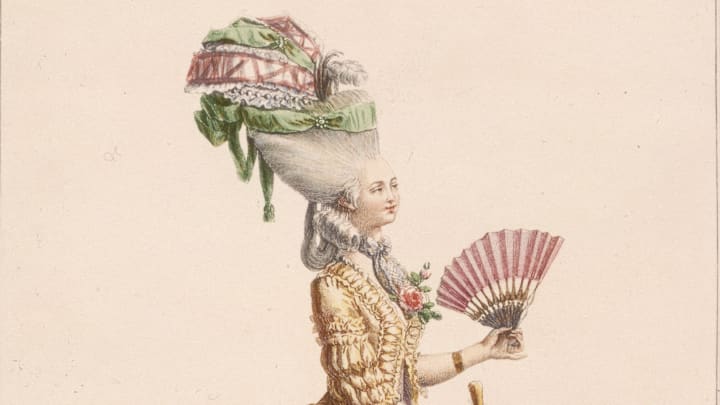Long relegated to Victorian-themed parties and period dramas, hand fans are making a comeback. The accessories, which can measure upwards of 16 inches long and are often adorned with a variety of patterns and designs, were an especially common sight at the turn of the 20th century. In movies, they can be an easy shorthand for a character's coyness—the fan held just below the eyes. Or, in the case of Kirsten Dunst in Marie Antoinette (2006), a mean streak. But this portrayal undersells their utility as a communication device. During the Victorian Era, an entire language developed around the fans as a means of courting lovers in full view of conservative chaperones.
At least they were marketed that way.
The History of Hand Fans
A lightweight fan for personalized cooling is probably as old as civilization itself. According to the National Park Service, which maintains a collection of vintage hand fans at Gateway Arch National Park in Missouri, the fans date as far back as ancient Egypt and were originally made from ostrich or peacock feathers. The collapsible folding hand fan first appeared in Japan circa 637 CE. While the fan (or leaf) was later made of paper, older hand fans were crafted from animal skins. Their handles (or montures) and sticks (ribs) could be ivory, metal, or wood.
In Venice, Italy, trade with the East meant the fans became well-traveled. In some cases, they designated social status. The more affluent could order custom hand fans with ornate designs by known artists [PDF]. By the mid-1500s, a kind of sign language was already developing around them. Come the 1800s, hand fans were as common a sight as umbrellas, though far more versatile when it came to covert communications.
The Hidden Language of Hand Fans
The Victorians were a rather chaste group (at least outwardly). Overt flirting or salacious talk was frowned upon; would-be partners often had to dance around their true desires by sending letters, flowers, or offering acquaintance cards. (Think a business card, only with more carnal intentions.) Often, a chaperone discouraged sexual chemistry by their presence alone. Fashion accessories like hand fans made for low-key flirting in mixed company.
Decoding the difference between organic hand fan movements and those that were orchestrated for sneaky purposes can be difficult, however. Certainly, some women used sweeping gestures that were probably well understood. A hand fan brushed across the face, for example, could mean I love you. A left-handed twirl might mean a flirtatious pair was being watched by critical eyes and decorum should be maintained.

But the more complex language of hand fans was more of a sales tactic than anything else. Charles Francis Badini designed a version he dubbed Fanology in 1797. The fan was essentially its own instructional manual, with gestures and their meanings printed right on the paper that became viewable when fully extended.
Another design, this one from Robert Rowe, took a different tact. Named The Ladies Telegraph, the fan folded out so each flap had its own letter. The user could point to a letter to spell out a word, then point to the 27th flap—which was blank—to signify they’d come to the end.
Both were attempts to boost flagging sales of the fans following the French Revolution. Then, in 1827, a fan manufacturer named Duvelleroy published a glossary of hand fan movements and their meanings. A sampling:
Carrying in the right hand in front of face … Follow me
Placing it on left ear … I wish to get rid of you
Twirling in the right hand … I love another
Drawing across the eyes … I am sorry
Letting it rest on right check … Yes
Letting it rest on left cheek … No
Another treatise, The Dime-Lover’s Casket (1870) by Lambouillet Rossi, covered “codes” in everything from hand fans to handkerchiefs. Rossi summarized the appeal of such signals thusly: “The fan is a pretty toy, and in a pretty woman’s hand is capable of much pretty manipulation.”
But how often these more elaborate signals were actually used outside of parlor games is open to debate. It’s possible some thirsty Victorians took their cues from such guides, but to what extent is not known.
The Decline of Hand Fans
Hand fans as a fashion statement were disappearing by the early 20th century, but that wasn’t the end of their life as a communication tool. Companies like Coca-Cola and Pan Am used the fans to advertise. They’re still used in marketing today; in 2023, singer Beyoncé promoted her Renaissance tour with hand fans. Even Duvelleroy is still in the fan business. And yes, they can still be used for covert flirting—provided both parties understand the signs.
Read More About the Victorian Era:
